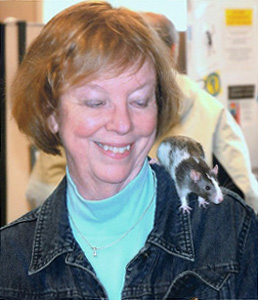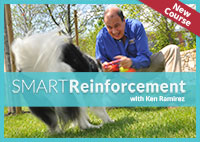I loved Lucy
When I lived in the Pacific Northwest, I kept a brown and white pet rat named Lucy. She would come when called, so I could give her the run of the office. She was a delightful pet, cozy, chatty, and full of enjoyment of life. When I moved to Boston, I re-homed her with a neighbor’s little boy and he loved her, too.

Lab rats
In the course of writing Reaching the Animal Mind, I interviewed some leading neuroscientists and met some of their rats. Thanks to my history with Lucy, I now took a real interest in those rats. Most of the experimental rats were fitted out with cranial implants—metal hats—that allow direct study of the brain in action. This headgear didn’t seem to bother the rats. What bothered me, though, was an absence of operant training in some experimental designs. Some scientists were asking for straightforward tasks from an operant standpoint—press this if you see that—but it seemed to me that they didn’t explain the job to the rat in a way the rat could understand.
One day here in Boston, I received an e-mail from a Harvard neuroscientist named Bence Ölveczky. The students in his laboratory were reading Don’t Shoot the Dog and wanted to find out more about using operant conditioning with their rats.
As I understood it, the work they were focusing on was this: what happens in the brain when the animal learns complex behaviors, such as a behavior chain. Isn’t that right up our alley? Yes it is. Would I come over and talk to them? Yes indeed.
I went to the lab, which is about fifteen minutes from my house, and met with Dr. Ölveczky and some of the students. I gave a talk about clicker training to a group from several departments. And I saw some rats.
Enrichment
Because of the cranial implants, the rats have to live alone; you can’t have another rat nibbling on that fancy headgear. Each rat lived in a transparent box with deep, clean, suitable litter. The students asked me if I knew ways to make their rats even more comfortable.
I consulted by e-mail with Virginia Broitman, a clicker expert and rat lover. Virginia provided a list of what zoo trainers call enrichment items for rats: things to chew and manipulate; periods of darkness; chances to explore; novel foods. I forwarded the list to the lab, along with a memorandum on the requirements for a good marker signal and some thoughts on reinforcers.
What kinds of behaviors are needed?
Examining and probing the rat’s brain through a cranial implant is a painless procedure, but the brain needs to be held still during the process. Could a rat learn to hold still voluntarily, instead of being under total physical restraint? Probably, I said. People are doing it with monkeys through clicker training.
A month later, I had lunch off-campus with Adam Kampff, a post-doc in the Ölveczky lab, and his wife Eva, another neuroscience graduate student. Adam told me that a student had successfully trained one of her rats to put its head in the right place and keep it there, but when she lowered the clamps on the headpiece prior to actually activating the probes, the rat panicked and pulled away.
“She’s just moving a little too fast,” I suggested. “It might help to break the training down into smaller steps.”
Does that help? We’ll see.
Another visit to the lab
In late February I made another visit. The lab had expanded into big new quarters. The rats were arranged so they could see each other. Guess what else? All the rats now had pieces of cardboard or paper and wood to chew on and manipulate.
Now everyone was training in several short sessions daily, rather than letting the automated training run for hours. Good! And the student working on voluntary self-positioning had trained three rats to go into position and hold their heads still on cue, for longer and longer times. She showed me that. Good job!
Another student had developed a clicker trained stress-free way to move rats around. She placed one end of a foot-long, flexible piece of thick tubing (like dryer vent tubing) in the rat’s home space. The rat ran into the tube. The student carried the tube to the experimental chamber, and the rat ran out the other end. A happy, calm rat and a happy, calm investigator.
The student also showed me her rat hotel. She had glued two cardboard boxes on top of each other, with holes in between, rope ladders, and toys—for ratty after-work fun time. A terrific non-food reinforcer!
Grad student Raj Podar wanted to use the computer to teach rats the basics of clicker training. The idea was to automatically teach rats to understand working for the click, to learn specific behaviors, and to learn that there are cues for each behavior. These pre-trained rats might have a real advantage in learning new tasks for subsequent experiments.
Raj switched his rats from day to night, because that’s their natural alert time. While we could watch them on the computer, the rats themselves worked in darkness. A simple kindness, yes, but also biologically appropriate and, maybe, helpful to the learning.
We watched on the computer monitor as four rats had their training sessions. Three were learning well, pressing the left stick on one cue, the right stick on another. The fourth rat, however, had gotten stuck on one side, and was in a classic extinction curve. Together, we all managed to figure out what may have happened and came up with a way to tweak the cue presentation method a little to see if that helped. Fun for me!
The training game
After lunch we played the training game. Students clicked each other for turning in a circle, putting paper in the trash, picking up a rock from the bamboo planter in the window. Laughter and applause. A first shaping experience.
Then I demonstrated shaping with a rat. The first rat we moved to a work table was vastly more interested in climbing out of her transparent box and exploring the tabletop than in food or work. We tried a second, more timid, rat. He stayed in his box gladly, and proved to be willing to work. I captured the behavior of sitting up on his hindquarters several times. Soon he was obviously doing it intentionally and holding the pose longer and longer. I suggested that someone else now tackle the shaping task of putting the behavior on cue. We put the rat back on the rat shelf so he wouldn’t go on offering the behavior in vain.
The students watched in silence. I was not dismayed by the lack of verbal behavior. I thought they were probably engaged in a behavior they were highly trained for: focusing, thinking, and learning. A lot. And fast.
(What will they figure out next? I can’t wait to see!)
To be continued...
Editor’s note: Train your own pocket pet with Joan Orr’s guidance, in Clicking with Your Rabbit.








Post new comment